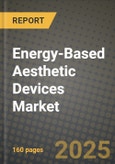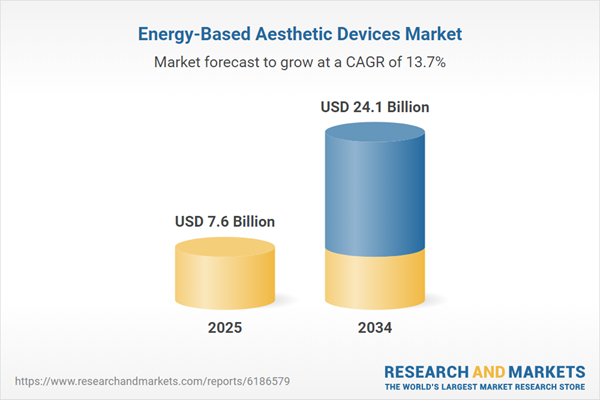Market Overview: Energy-Based Aesthetic Devices Market
The energy-based aesthetic devices market has experienced substantial growth in recent years, driven by advancements in non-invasive cosmetic treatments and increasing consumer demand for skin rejuvenation, body contouring, and hair removal. These devices utilize various energy sources, such as radiofrequency (RF), lasers, intense pulsed light (IPL), and ultrasound, to address common aesthetic concerns without the need for surgery. The growing preference for minimally invasive procedures, coupled with rising awareness about aesthetic treatments and their benefits, has further contributed to the market’s expansion. In addition to their effectiveness, energy-based devices offer patients quicker recovery times, less discomfort, and reduced risks compared to traditional surgical procedures. This has made them highly attractive to consumers seeking safe, affordable, and efficient solutions for improving appearance. With advancements in technology and growing acceptance of aesthetic procedures globally, the energy-based aesthetic devices market is projected to continue its upward trajectory in the coming years.The market saw notable developments driven by increasing consumer interest in non-surgical aesthetic treatments. Technological innovations in laser-based devices, including fractional CO2 and diode lasers, improved precision and efficacy in treating a wider range of skin concerns, from acne scars to pigmentation issues. The demand for body contouring treatments, particularly non-invasive fat reduction procedures, grew rapidly as consumers sought alternatives to liposuction and invasive surgery. Additionally, advancements in ultrasound technologies enabled more efficient skin tightening and cellulite reduction treatments. The adoption of energy-based devices in dermatology clinics, medical spas, and aesthetic centers expanded as professionals increasingly recognized the value of these devices in delivering superior patient outcomes. Moreover, increasing disposable incomes and evolving beauty standards in emerging economies fueled the global demand for aesthetic procedures, with a focus on providing high-quality services at competitive prices. As regulatory frameworks evolved, the market witnessed improved safety standards and product approvals, further enhancing consumer trust in energy-based devices.
The energy-based aesthetic devices market is expected to continue growing as new technologies and treatments emerge. Advances in multi-technology devices that combine different energy types, such as RF and ultrasound, are expected to gain traction, offering more comprehensive solutions to address various aesthetic concerns. The growing trend of at-home beauty devices will also shape the market, with consumers increasingly seeking portable, affordable options for skin care and rejuvenation. Additionally, the rise of personalized treatments based on genetic and skin type analysis will foster innovation in energy-based devices, allowing for customized procedures tailored to individual needs. As the aging population continues to grow, the demand for anti-aging treatments, such as skin tightening and wrinkle reduction, will remain strong. Moreover, the increased focus on holistic wellness and self-care will drive the adoption of energy-based aesthetic treatments, as consumers prioritize non-invasive ways to enhance their appearance and boost confidence.
Key Insights: Energy-Based Aesthetic Devices Market
- Rise of Multi-Technology Devices: Multi-technology devices that combine different energy sources, such as radiofrequency, ultrasound, and lasers, are gaining popularity. These devices offer a broader range of aesthetic treatments, enabling practitioners to address multiple concerns with a single solution, enhancing patient outcomes and treatment efficiency.
- Increased Demand for Non-Invasive Treatments: The growing preference for non-invasive procedures is fueling the demand for energy-based aesthetic devices. Consumers are increasingly seeking alternatives to surgery, driven by lower costs, faster recovery times, and less risk of complications, making non-surgical options more appealing.
- Popularity of At-Home Beauty Devices: At-home energy-based beauty devices are becoming more mainstream as consumers look for affordable and convenient alternatives to in-office treatments. These devices offer similar benefits to professional treatments, such as skin rejuvenation, acne treatment, and hair removal, making them a growing market segment.
- Customization of Treatments Based on Skin Type: Advances in personalized aesthetic treatments are allowing for more customized procedures. By analyzing individual skin types and genetic factors, devices can be tailored to deliver optimal results, enhancing patient satisfaction and treatment effectiveness.
- Integration of Artificial Intelligence (AI) in Treatments: The incorporation of AI and machine learning into aesthetic treatments is increasing. AI helps to improve treatment precision, predict outcomes, and personalize procedures, leading to more efficient and accurate results in energy-based treatments.
- Growing Demand for Non-Invasive Aesthetic Treatments: The increasing preference for non-surgical options, driven by factors such as quicker recovery times, affordability, and lower risks, is one of the key drivers of the energy-based aesthetic devices market.
- Technological Advancements in Aesthetic Devices: Innovations in laser technologies, ultrasound, and radiofrequency devices have significantly improved the effectiveness and safety of energy-based aesthetic treatments, making them more accessible to both patients and practitioners.
- Rising Disposable Incomes and Consumer Spending: As disposable incomes rise, especially in emerging markets, more consumers are able to afford aesthetic treatments, driving the demand for advanced energy-based devices. This trend is expected to continue with growing economic stability and urbanization.
- Increasing Acceptance of Aesthetic Treatments: The growing societal acceptance of aesthetic treatments, driven by shifting beauty standards and greater media influence, has contributed to the widespread adoption of energy-based aesthetic devices across demographics.
- High Costs of Advanced Aesthetic Devices: One of the primary challenges in the energy-based aesthetic devices market is the high initial investment required for advanced equipment. This can be a barrier for smaller clinics and practitioners, limiting access to cutting-edge technology and slowing market penetration in certain regions.
Energy-Based Aesthetic Devices Market Segmentation
By Technology
- Laser-Based
- Light-Based
- Electromagnetic Energy-Based
- Ultrasound-Based
- Cryolipolysis
- Other Technologies
By Gender
- Female
- Male
By Distribution Channel
- Indirect
- Direct
By Application
- Body Contouring and Skin Tightening
- Skin Rejuvenation
- Hair Removal
- Leg Vein Treatment
- Pigmented Lesion and Tattoo Removal
- Vaginal Rejuvenation
- Other Applications
By End-User
- Hospital Or Surgery Center
- Medspa
- Traditional Spa
- HCP Owned Clinic
Key Companies Analysed
- Merz Pharma GmbH & Co. KGaA
- Lumenis Be Ltd.
- Alma Lasers Inc.
- EL.EN. S.p.A.
- Cutera Inc.
- Sisram Medical Ltd.
- Cynosure Inc.
- Bausch Health Companies Inc.
- Zeltiq Aesthetics Inc.
- Venus Concept Inc.
- Sciton Inc.
- TRIA Beauty Inc.
- Candela Corporation
- Lynton Lasers Ltd.
- Laser Aesthetics SA
- Envy Medical Inc.
- Syneron Medical Ltd.
- Aerolase Corp.
- BTL Industries Inc.
- Lutronic Corporation
- Fotona d.o.o.
- Sientra Inc.
- InMode Ltd.
- CureSkin Inc.
- Cutting Edge Laser Technologies
- SpectraGenics Inc.
- Quanta System S.p.A.
- Ellman International Inc.
- Solta Medical
- Inomax Inc.
Energy-Based Aesthetic Devices Market Analytics
The report employs rigorous tools, including Porter’s Five Forces, value chain mapping, and scenario-based modeling, to assess supply-demand dynamics. Cross-sector influences from parent, derived, and substitute markets are evaluated to identify risks and opportunities. Trade and pricing analytics provide an up-to-date view of international flows, including leading exporters, importers, and regional price trends.Macroeconomic indicators, policy frameworks such as carbon pricing and energy security strategies, and evolving consumer behavior are considered in forecasting scenarios. Recent deal flows, partnerships, and technology innovations are incorporated to assess their impact on future market performance.
Energy-Based Aesthetic Devices Market Competitive Intelligence
The competitive landscape is mapped through proprietary frameworks, profiling leading companies with details on business models, product portfolios, financial performance, and strategic initiatives. Key developments such as mergers & acquisitions, technology collaborations, investment inflows, and regional expansions are analyzed for their competitive impact. The report also identifies emerging players and innovative startups contributing to market disruption.Regional insights highlight the most promising investment destinations, regulatory landscapes, and evolving partnerships across energy and industrial corridors.
Countries Covered
- North America - Energy-Based Aesthetic Devices market data and outlook to 2034
- United States
- Canada
- Mexico
- Europe - Energy-Based Aesthetic Devices market data and outlook to 2034
- Germany
- United Kingdom
- France
- Italy
- Spain
- BeNeLux
- Russia
- Sweden
- Asia-Pacific - Energy-Based Aesthetic Devices market data and outlook to 2034
- China
- Japan
- India
- South Korea
- Australia
- Indonesia
- Malaysia
- Vietnam
- Middle East and Africa - Energy-Based Aesthetic Devices market data and outlook to 2034
- Saudi Arabia
- South Africa
- Iran
- UAE
- Egypt
- South and Central America - Energy-Based Aesthetic Devices market data and outlook to 2034
- Brazil
- Argentina
- Chile
- Peru
Research Methodology
This study combines primary inputs from industry experts across the Energy-Based Aesthetic Devices value chain with secondary data from associations, government publications, trade databases, and company disclosures. Proprietary modeling techniques, including data triangulation, statistical correlation, and scenario planning, are applied to deliver reliable market sizing and forecasting.Key Questions Addressed
- What is the current and forecast market size of the Energy-Based Aesthetic Devices industry at global, regional, and country levels?
- Which types, applications, and technologies present the highest growth potential?
- How are supply chains adapting to geopolitical and economic shocks?
- What role do policy frameworks, trade flows, and sustainability targets play in shaping demand?
- Who are the leading players, and how are their strategies evolving in the face of global uncertainty?
- Which regional “hotspots” and customer segments will outpace the market, and what go-to-market and partnership models best support entry and expansion?
- Where are the most investable opportunities - across technology roadmaps, sustainability-linked innovation, and M&A - and what is the best segment to invest over the next 3-5 years?
Your Key Takeaways from the Energy-Based Aesthetic Devices Market Report
- Global Energy-Based Aesthetic Devices market size and growth projections (CAGR), 2024-2034
- Impact of Russia-Ukraine, Israel-Palestine, and Hamas conflicts on Energy-Based Aesthetic Devices trade, costs, and supply chains
- Energy-Based Aesthetic Devices market size, share, and outlook across 5 regions and 27 countries, 2023-2034
- Energy-Based Aesthetic Devices market size, CAGR, and market share of key products, applications, and end-user verticals, 2023-2034
- Short- and long-term Energy-Based Aesthetic Devices market trends, drivers, restraints, and opportunities
- Porter’s Five Forces analysis, technological developments, and Energy-Based Aesthetic Devices supply chain analysis
- Energy-Based Aesthetic Devices trade analysis, Energy-Based Aesthetic Devices market price analysis, and Energy-Based Aesthetic Devices supply/demand dynamics
- Profiles of 5 leading companies - overview, key strategies, financials, and products
- Latest Energy-Based Aesthetic Devices market news and developments
Additional Support
With the purchase of this report, you will receive:- An updated PDF report and an MS Excel data workbook containing all market tables and figures for easy analysis.
- 7-day post-sale analyst support for clarifications and in-scope supplementary data, ensuring the deliverable aligns precisely with your requirements.
- Complimentary report update to incorporate the latest available data and the impact of recent market developments.
This product will be delivered within 1-3 business days.
Table of Contents
Companies Mentioned
- Merz Pharma GmbH & Co. KGaA
- Lumenis Be Ltd.
- Alma Lasers Inc.
- EL.EN. S.p.A.
- Cutera Inc.
- Sisram Medical Ltd.
- Cynosure Inc.
- Bausch Health Companies Inc.
- Zeltiq Aesthetics Inc.
- Venus Concept Inc.
- Sciton Inc.
- TRIA Beauty Inc.
- Candela Corporation
- Lynton Lasers Ltd.
- Laser Aesthetics SA
- Envy Medical Inc.
- Syneron Medical Ltd.
- Aerolase Corp.
- BTL Industries Inc.
- Lutronic Corporation
- Fotona d.o.o.
- Sientra Inc.
- InMode Ltd.
- CureSkin Inc.
- Cutting Edge Laser Technologies
- SpectraGenics Inc.
- Quanta System S.p.A.
- Ellman International Inc.
- Solta Medical
- Inomax Inc.
Table Information
| Report Attribute | Details |
|---|---|
| No. of Pages | 160 |
| Published | October 2025 |
| Forecast Period | 2025 - 2034 |
| Estimated Market Value ( USD | $ 7.6 Billion |
| Forecasted Market Value ( USD | $ 24.1 Billion |
| Compound Annual Growth Rate | 13.7% |
| Regions Covered | Global |
| No. of Companies Mentioned | 30 |









